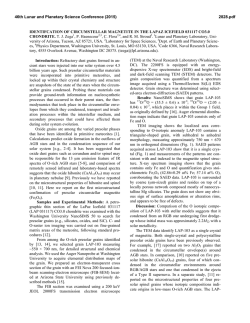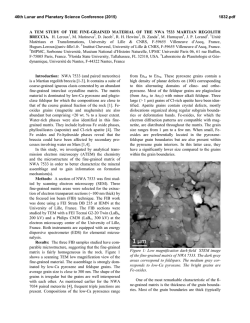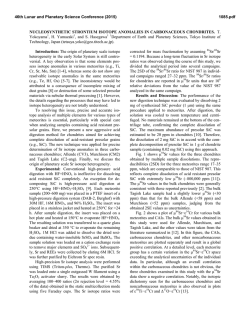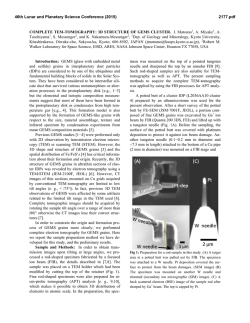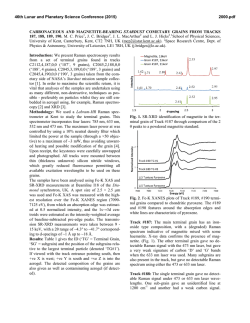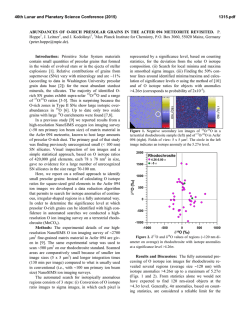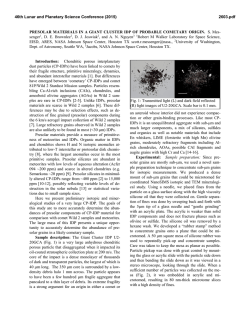
Structural and Chemical Heteorogeneity in the Bonzana Supernova
46th Lunar and Planetary Science Conference (2015) 2576.pdf STRUCTURAL AND CHEMICAL HETEROGENEITY IN THE BONZANA SUPERNOVA Sic GRAIN. R. M. Stroud1, E. K. Zinner2, F. Gyngard2, 1Naval Research Laboratory, Washington, DC 20375, 2Laboratory for Space Sciences, Washington University in St. Louis, St. Louis, MO 63130. Introduction: Of the dust grain phases that formed in ancient stars prior to the formation of the solar system that are preserved in meteorites, SiC is the most well characterized [1]. Approximately 1% of the preserved presolar SiC grains, called X grains, originated in the outflows of type II supernovae, whereas the vast majority (~95%) condensed around asymptotic giant branch (AGB) stars. The stellar origin of individual grains can be determined on the basis of Si and C isotope composition, and confirmed when possible through measurements of additional isotope systems. The X grains are identified by 12C and 15N excesses relative to solar, excesses in 28Si, and very large inferred 26Al/27Al ratios. Measurement of multiple, minor element isotope systems in X grains, e.g., Fe, Ti, and Ca, enables the identification of different zones of the supernovae that contributed to the grain formation, but is only possible on the largest grains (≳ 1 µm), such as Bonanza (~30 µm) [2]. The grain condensation conditions, such gas composition, temperature, and pressure can be constrained through analysis of the grain chemistry and structure. Prior transmission electron microscopy (TEM) studies of SiC grains, including both AGB and X types, have revealed only the two lowest temperature polytypes 2H and 3C, as well as 2H-3C intergrowths, and a few grains too disordered to assign a polytype [3]. TEM data for 9 X grains, all < 4 µm, have been reported [4, 5], of which two were observed to contain subgrains, with one grain containing 7, and the other one. All 8 of the subgrains were rich in Fe and Ni, two showed detectable Ti, and one was confirmed to be an Fe,Ni silicide. Here we report TEM results from the Bonanza SiC X grain, which demonstrate structural and compositional complexity, including evidence for distinct (Al,Mg)N subgrains and abundant TiN, in addition to Fe,Ni-rich grains consistent with prior analyses. Samples and Methods: The Bonanza SiC was obtained from the LU size separate (> 10µm) of the Murchison meteorite [6]. Isotope ratio images of Bonanza for C, Si, N, Al-Mg, Ti, Ca, Fe and Ni were collected previously with the NanoSIMS at Washington University and at the Department of Terrestrial Magnetism [6]. Based on the isotope images, we selected three regions of interest for study with transmission electron microscopy (TEM). Cross-sections of these regions were prepared at NRL with the FEI Nova 600 FIBSEM. One section was prepared by ex situ lift-out onto carbon film coated TEM grids. Two sections were extracted by in situ lift-out and attached to Cu TEM half-grids. TEM analyses of sections 1-3 were carried out with the NRL JEOL 2200FS microscope. Sections 2 and 3 were further analyzed with PRISM, the NRL Nion UltraSTEM 200 with a Bruker Espirit windowless SDD EDS system. All TEM data were collected at an operating voltage of 200 kV. Results and Discussion: Scanning (S)TEM images (Fig. 1) reveal that Bonanza is structurally and chemically complex. All three sections (section 2 and 3 shown) are composed of multiple SiC crystallites ranging in size from sub-µm to ~ 5µm. Internal voids are present at many of the boundaries between crystallites, and abundant subgrains (10 - 300 nm) are also observed (Fig. 1A,C). The diffraction contrast in the bright field STEM images (Fig.1 B,D) indicates preferred orientation relationships between crystallites, suggesting that the individual SiC crystallites formed as intergrowths in a single grain with multiple nucleation centers, rather than by agglomeration of separately condensed grains. The voids can be attributed to the impingement of competing growth fronts of different crystallites. Figure 1. STEM images of two FIB sections from the Bonanza SiC X grain. The scale bars indicate 1 µm. In the dark field images A) and C), black arrows indicate voids and white arrows indicate subgrains; not all voids or subgrains are marked. The dashed grey square in A) indicates the region shown in Fig. 2. The bright field images B) and D) show diffraction contrast that indicates that the sections contain multiple intergrown crystallites. 46th Lunar and Planetary Science Conference (2015) Figure 2 illustrates the compositional variation in subgrains with an example EDS spectrum image series from a subregion of section 2 (dashed square, Fig 1A). More than 15 distinct subgrains are present in this 2.5 µm2 area, corresponding to an abundance of order 10 subgrains um-3. These subgrains include Fe,Ni-rich grains with variable Fe:Ni ratios that sometimes also show detectable Ti, TiN grains, and (Al,Mg)N. Mapping of additional areas (not shown) revealed additional subgrains of these three phases, as well as one S-rich region. Elemental maps of a second (Al,Mg)N grain show depletion in Al and Mg in the SiC immediately surrounding the subgrain. This suggests that the subgrain may have formed by solid state precipitation, rather than condensation as a distinct grain that was subsequently captured by the SiC. 2576.pdf obtained for confirmation. The presence of a 0.198 nm reflection in patterns from this crystallite rule out identification as either the 3C and 2H polytypes. Figure 3. Selected area diffraction patterns from different crystallites. The different crystallites exhibit different polytypes, including 3C, and 3C with stacking disorder in 1 or 2 dimensions. One crystallite consistent with the 15R polytype has also been identified. Figure 2. Dark field STEM image and EDS elemental maps of a subregion of section 2 in Fig.1A. Two large voids and numerous subgrains are present, including Fe,Ni-rich, TiN and (Al,Mg)N phases. The (Al,Mg)N subgrain can be observed in the elemental maps but not the STEM images, because it is isostructural with SiC and of very similar average atomic number. Selected area diffraction patterns obtained from multiple crystallites in each section show significant variation in polytype and degree of crystallinity. Identified structures include 3C, and 3C with twins, 1-d and 2-d disorder, 2H, 15R (Fig. 3). In the case of the 15R crystallite, 6 diffraction patterns from different zones were Summary: The large size of the Bonanza SiC X grain permits more detailed study than possible in any prior coordinated structure-isotope study of presolar SiC. The structural complexity of Bonanza spans the full range of polytypes, including the range of stacking disorder, observed for all prior presolar SiC, while introducing at least one new polytype, 15R. The structural complexity is likely derived in part from the underlying chemical complexity of the subgrains, which may act to stabilize particular stacking sequences. The structural variability and abundant internal voids point towards rapid condensation under supersaturated conditions. To our knowledge, the TiN reported here is the first discovery of circumstellar TiN. Additional work is needed to address the implications of these results for supernova mixing models. References: [1] Zinner, E. (2014). Presolar grains. In H. D. H. K. Turekian (Ed.), Treatise on Geochemistry (Second Edition) (pp. 181-213). Oxford: Elsevier. [2] Zinner E., Jadhav M., Gyngard F., and Nittler L. R. (2011). LPSC XLII, Abstract #1070. [3] Daulton T. L., Bernatowicz T. J., Lewis R. S., Messenger S., Stadermann F. J., and Amari S. (2003) GCA 67, 47434767. [4] Stroud R. M., Nittler L. R., and Hoppe, P. (2004) MAPS 39 suppl., abstract #5039. [5] Hynes K. M., Croat T. K., Amari S., Mertz A. F., and Bernatowicz T. J. (2010). MAPS 45, 596-614. [6] Amari S., Lewis R. S., and Anders E. (1994) GCA 58, 459-470.
© Copyright 2025

